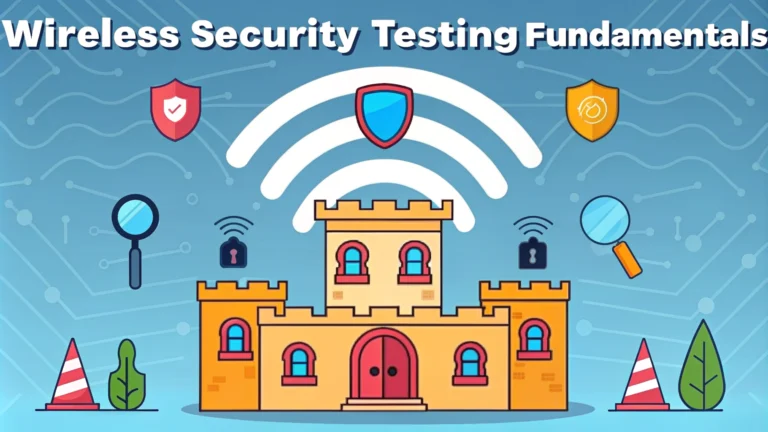Wireless networks present unique security challenges that require specialized testing approaches and tools.
Security professionals need practical knowledge of wireless penetration testing to identify and address vulnerabilities before malicious actors can exploit them.
This guide covers essential wireless security testing techniques, tools, and methodologies used by security experts to evaluate and strengthen wireless network defenses.
Core Wireless Security Testing Components
- Network Discovery and Mapping
- Authentication Testing
- Encryption Analysis
- Traffic Analysis
- Rogue Access Point Detection
- Client-side Testing
Essential Tools for Wireless Testing
Tools like Aircrack-ng, Wireshark, and Kismet form the foundation of any wireless security testing toolkit.
| Tool | Purpose |
|---|---|
| Aircrack-ng | WEP/WPA cracking, packet capture |
| Wireshark | Network protocol analysis |
| Kismet | Wireless network detection, packet sniffing |
Testing Methodology
- Reconnaissance
- Identify wireless networks in range
- Document SSIDs and signal strengths
- Map physical locations of access points
- Network Analysis
- Determine encryption types
- Identify authentication methods
- Analyze network traffic patterns
- Vulnerability Assessment
- Test for known exploits
- Check default configurations
- Evaluate encryption strength
Common Attack Vectors to Test
- Evil Twin Attacks
- WPA/WPA2 Handshake Capture
- Deauthentication Attacks
- Man-in-the-Middle (MITM) Attacks
- Hidden SSID Discovery
Security Testing Best Practices
Always obtain proper authorization before conducting wireless security tests.
Document all findings and maintain detailed logs of testing activities.
Use dedicated testing equipment to avoid interfering with production networks.
Reporting and Documentation
Create detailed reports that include:
- Executive Summary
- Testing Methodology
- Findings and Vulnerabilities
- Risk Assessment
- Remediation Recommendations
Future-Proofing Your Testing Strategy
Stay updated with the latest wireless security standards and testing methodologies through resources like:
- SANS Institute (www.sans.org)
- Offensive Security (www.offensive-security.com)
- WiFi Alliance (www.wi-fi.org)
Implementation Guidelines
Successful wireless security testing requires careful planning and execution to ensure comprehensive coverage while minimizing network disruption.
- Create a detailed testing schedule
- Establish clear scope boundaries
- Define success criteria
- Prepare contingency plans
Advanced Testing Scenarios
IoT Device Testing
- Bluetooth connectivity assessment
- Smart device vulnerability scanning
- Protocol-specific testing
Enterprise Environment Testing
- RADIUS server authentication
- Certificate validation
- Network segmentation verification
Compliance and Regulatory Considerations
Ensure testing aligns with relevant standards:
- PCI DSS wireless requirements
- HIPAA security rules
- ISO 27001 controls
- Industry-specific regulations
Risk Mitigation Strategies
Implement controls based on test findings:
- Network access control (NAC)
- Wireless IDS/IPS deployment
- Guest network isolation
- Regular security assessments
Strengthening Wireless Security Posture
Wireless security testing is an ongoing process that requires constant adaptation to emerging threats and technologies. Organizations must maintain vigilance through regular assessments, continuous monitoring, and proactive security measures to protect their wireless infrastructure effectively.
Success in wireless security testing depends on combining technical expertise, appropriate tools, and methodical approaches with a thorough understanding of organizational needs and compliance requirements. Regular updates to testing procedures and toolsets ensure preparedness against evolving wireless security challenges.
FAQs
- What is wireless security penetration testing?
Wireless security penetration testing is the process of evaluating the security of wireless networks by identifying and exploiting vulnerabilities in wireless protocols, configurations, and infrastructure components. - Which tools are commonly used in wireless security testing?
Common tools include Aircrack-ng suite, Wireshark, Kismet, WiFite, Airgeddon, and Acrylic WiFi Professional. These tools help in packet capture, network discovery, encryption cracking, and wireless traffic analysis. - What are the main types of wireless attacks that penetration testers check for?
Key attacks include WEP/WPA/WPA2 cracking, Evil Twin attacks, Man-in-the-Middle (MITM) attacks, Deauthentication attacks, Rogue Access Points, and WPS vulnerabilities. - What wireless protocols should be tested during a penetration test?
Testing should cover 802.11 protocols (a/b/g/n/ac/ax), WEP, WPA, WPA2, WPA3, Bluetooth, and other wireless protocols like ZigBee and NFC if present in the environment. - What hardware is required for wireless penetration testing?
Essential hardware includes wireless network adapters with monitor mode and packet injection capabilities, external antennas for extended range, and a computer running compatible penetration testing software. - How can organizations protect against wireless security vulnerabilities?
Organizations should implement WPA3 encryption, use strong passwords, enable MAC filtering, regularly update firmware, conduct wireless surveys, disable WPS, and implement network segmentation. - What legal considerations exist for wireless security testing?
Testers must obtain explicit permission from network owners, comply with local laws and regulations, avoid disrupting neighboring networks, and maintain detailed documentation of testing activities. - What common wireless security misconfigurations are tested?
Common misconfigurations include default credentials, weak encryption protocols, enabled WPS, guest network misconfigurations, exposed management interfaces, and improper network segmentation. - How is wireless signal mapping performed during testing?
Wireless signal mapping involves using tools like Kismet or AirMagnet to create heat maps of wireless coverage, identify unauthorized access points, and determine network boundaries. - What are the phases of a wireless security penetration test?
The phases include reconnaissance, scanning, vulnerability assessment, exploitation, post-exploitation analysis, and reporting with remediation recommendations.







